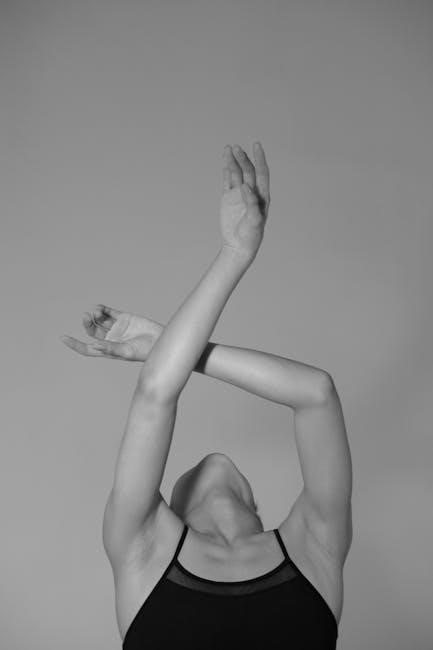The piriformis muscle is a flat, pear-shaped muscle in the gluteal region, originating from the sacrum. It facilitates hip rotation, stability, and acts as a lateral rotator, while also being the most superficial of the deep gluteal muscles, playing a role in hip extension and sometimes compressing the sciatic nerve.
1.1 Structure and Function
The piriformis muscle is a flat, pear-shaped muscle in the gluteal region, originating from the anterior surface of the sacrum and inserting on the greater trochanter of the femur. It is part of the lateral rotator group and plays a key role in hip external rotation and stability. As the most superficial muscle among the deep gluteal muscles, it aids in hip extension and abduction. Its structure allows it to wrap around the sciatic nerve, which can sometimes lead to compression and discomfort. Its function is vital for balanced hip movement and posture.
1.2 Role in Hip Movement and Stability
The piriformis muscle plays a crucial role in hip movement and stability by facilitating external rotation, abduction, and extension of the thigh. It works in coordination with other lateral rotators to maintain balanced hip mechanics, ensuring smooth gait and posture. Its stabilizing function is essential during activities like walking or running, as it helps prevent excessive hip joint movement. Tightness or imbalance in the piriformis can disrupt hip stability, leading to discomfort or limited mobility, emphasizing the importance of proper stretching and strengthening exercises.
Understanding Piriformis Syndrome
Piriformis syndrome occurs when the piriformis muscle compresses the sciatic nerve, causing pain, tingling, and numbness in the buttocks and legs, often worsening with prolonged sitting or activity.
2;1 Causes and Risk Factors
Piriformis syndrome often results from consistent microtrauma or strain on the piriformis muscle, frequently caused by prolonged sitting, poor posture, or repetitive hip movements; Activities involving prolonged sitting, such as desk work or driving, can lead to muscle tightness and irritation. Additionally, improper lifting techniques, muscle imbalances, or overuse in sports can contribute to the development of this condition. These factors can cause the piriformis muscle to spasm or tighten, compressing the sciatic nerve and leading to discomfort and pain.
2.2 Symptoms and Diagnosis
Symptoms of piriformis syndrome include pain, tingling, or numbness in the buttocks, hips, or legs, often worsening with sitting or prolonged activity. Pain may radiate along the sciatic nerve, mimicking sciatica. Diagnosis involves physical exams, patient history, and imaging like MRI or CT scans to confirm muscle compression or abnormalities. Accurate diagnosis is crucial to differentiate it from other conditions, ensuring appropriate treatment and relief from discomfort.
Importance of Stretching the Piriformis Muscle
Stretching the piriformis muscle alleviates sciatica, enhances hip mobility, and prevents tightness, making it essential for maintaining muscle balance and overall hip health through regular practice.
3.1 Benefits for Sciatica Relief
Stretching the piriformis muscle provides significant relief from sciatica symptoms by reducing pressure on the sciatic nerve. This alleviates pain, numbness, and tingling sensations that often radiate down the leg. Regular stretching helps relax tightened muscles, improving blood flow and reducing inflammation. It also enhances nerve mobility, preventing further irritation. By addressing the root cause of sciatica linked to piriformis tightness, these stretches can significantly improve quality of life and restore pain-free movement. Consistent practice is key to long-term relief and prevention of recurring symptoms.
3.2 Improving Hip Flexibility and Mobility
Stretching the piriformis muscle enhances hip flexibility by loosening tight tissues and improving joint range of motion. This allows for smoother, more efficient movement during daily activities and sports. Increased mobility reduces stiffness and discomfort, making it easier to perform tasks like walking, climbing stairs, or engaging in exercise. Better flexibility also supports proper posture and alignment, reducing the risk of overuse injuries. Regular stretching helps maintain optimal hip function, promoting overall lower body health and athletic performance. Consistency is key to achieving lasting improvements in mobility.

Seated Piriformis Stretches
Seated piriformis stretches are convenient and effective for targeting the muscle. They improve circulation, reduce tension, and enhance hip flexibility, all while maintaining proper posture.
4.1 Figure-4 Stretch
The Figure-4 Stretch targets the piriformis muscle effectively. Sit with your knees bent, cross your right ankle over your left knee, forming a “4” shape. Gently lean forward from your hips until a stretch is felt in the buttock. Hold for 20-30 seconds, then switch sides. This stretch relieves sciatica symptoms, improves hip mobility, and reduces muscle tension. It’s an ideal exercise for those experiencing piriformis tightness or discomfort, promoting relaxation and flexibility in the gluteal region.
4.2 Seated Piriformis Stretch with Crossed Leg
Sit on the floor with your legs extended. Cross your right leg over your left, placing your right ankle on your left knee. Gently press down on your right knee with your hand until a stretch is felt in your right buttock. Hold for 20-30 seconds, then switch sides. This stretch targets the piriformis muscle, relieving sciatica symptoms and improving hip flexibility. It’s an effective exercise for reducing muscle tension and enhancing mobility in the gluteal region, ideal for those with piriformis tightness.

Standing and Advanced Piriformis Stretches
Standing stretches, like the side stretch, and advanced poses such as pigeon pose, effectively target the piriformis muscle, providing deep relief from sciatica and muscle tension.
5.1 Standing Side Stretch
The standing side stretch is an effective exercise for targeting the piriformis muscle. To perform this stretch, stand with your feet shoulder-width apart and slowly lean to one side, keeping your arms extended overhead. Hold for 20-30 seconds and repeat on the other side. This stretch helps improve flexibility and reduces tension in the hip and buttock area, providing relief from piriformis-related discomfort.
5.2 Pigeon Pose for Deep Piriformis Release
The pigeon pose is a yoga stretch that targets the piriformis muscle, offering a deep release. To perform it, start on your hands and knees, then bring one knee forward and place your foot on the ground in front of the other knee. Lower your hips down, stretching the back leg’s piriformis muscle. Hold for 20-30 seconds and switch sides. This pose improves hip flexibility, alleviates sciatica symptoms, and promotes relaxation in the lower back and buttocks.

Preventing Piriformis Tightness
Preventing piriformis tightness involves regular exercise, strengthening, and maintaining proper posture. Ergonomic adjustments and avoiding prolonged sitting can reduce muscle tension and prevent sciatica-related issues.
6.1 Routine Exercise and Strengthening
Routine exercise and strengthening are crucial for preventing piriformis tightness. Incorporating activities like yoga, swimming, and targeted stretches can enhance muscle flexibility and strength. Strengthening exercises for the core and glutes help stabilize the pelvis, reducing strain on the piriformis. Regular movement promotes blood flow, preventing muscle atrophy and maintaining optimal function. A balanced exercise routine, including both stretching and strengthening, supports long-term muscle health and reduces the risk of piriformis-related discomfort.
6.2 Proper Posture and Ergonomics
Proper posture and ergonomics play a vital role in preventing piriformis tightness. Maintaining a neutral spine alignment during sitting, standing, and lifting reduces strain on the piriformis muscle. Ensuring ergonomic workstation setups, such as chair height and monitor placement, minimizes prolonged pressure on the buttocks. Avoiding slouched positions and taking regular breaks to move can prevent muscle fatigue. Good posture habits and ergonomic practices help maintain muscle balance, reducing the risk of piriformis-related discomfort and promoting overall pelvic stability.

Safety Considerations
Always stretch gently to avoid overstretching, which can lead to muscle strain. Avoid bouncing during stretches, as it may cause injury. If experiencing severe pain or persistent symptoms, consult a professional for proper assessment and treatment.
7.1 Avoiding Overstretching
Overstretching can cause microtears in the piriformis muscle, leading to inflammation and prolonged discomfort. It is crucial to stretch gently within a comfortable range of motion, avoiding bouncing or forcing the stretch. Holding stretches for 20-30 seconds allows for gradual muscle release without strain. Breathing deeply and maintaining relaxation helps prevent excessive tension. If pain arises, stop immediately and modify the stretch to a gentler position. Overstretching can exacerbate symptoms, so moderation is key for effective relief.
7.2 When to Consult a Professional
Consult a healthcare professional if symptoms persist or worsen despite self-care measures. Seek medical advice for severe pain, numbness, or difficulty walking. A physical therapist or doctor can provide personalized treatments, such as manual therapy or targeted exercises. If stretching exacerbates symptoms or if there is radiating pain, professional evaluation is essential to rule out underlying conditions. Early intervention ensures proper management and prevents chronic issues, especially when piriformis tightness is linked to sciatic nerve irritation or other structural imbalances.
